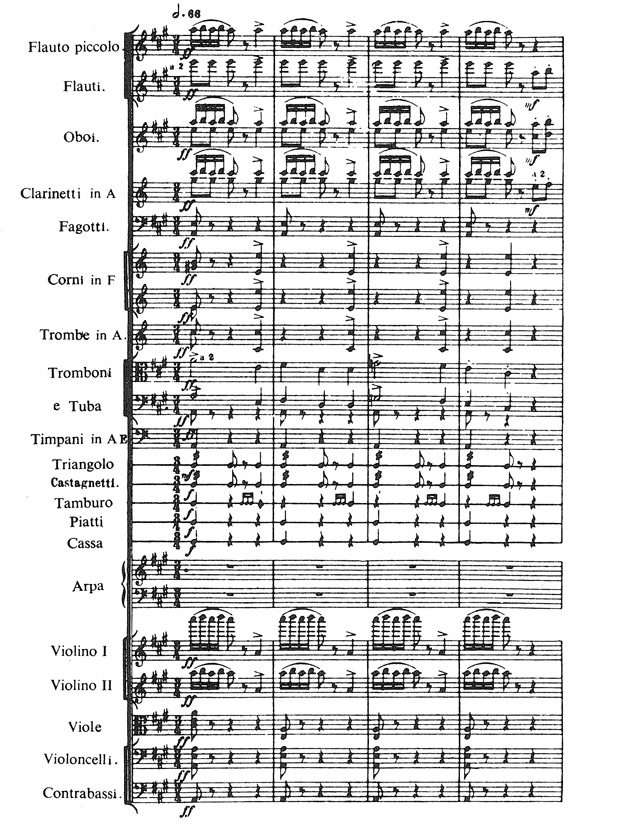Definite Pitch Instruments
Xylophone
IT: silofono – FR: xylophon – GER: Xylophon
Properties
The xylophone has hardwood bars arrayed like a keyboard, with or without a resonator below each bar. Its brittle, incisive tone decays immediately, but may be sustained with a roll. Usually played with hard mallets, it can penetrate thick orchestral textures. The xylophone is frequently used to highlight melodic lines in unison with other instruments, particularly on rapid figures.
Range
FIGURE 5.5 Xylophone range
Transposition
The xylophone sounds an octave above the written pitch and is notated in treble clef. The low end of the range varies on different instruments. A safe compass is from c1 upwards three octaves, although most college and professional organizations will have a larger instrument with the f below c1 available.
Celesta
The celesta is spelled the same in all languages.
Properties
The celesta resembles a very small spinet piano in appearance. It has a shorter keyboard and a damper pedal only. Instead of strings, the hammers strike small steel plates, each with a wooden resonator. The tone is bell-like, delicate, and not brilliant. It is used primarily to highlight melodies in soft passages. The technique is similar to that of the piano. The celesta sounds an octave higher than written.
Range
FIGURE 5.6 Celesta range
Orchestra Bells, or Glockenspiel
IT: campanelli – FR: jeu de timbres, carillon – GER: Glockenspiel
Properties
Metal bars arranged in the shape of a keyboard are attached to a portable case, which is opened and placed on a table in performance. Usually played with one or two hard mallets, the bells add a bright edge to the sound when combined with other instruments. The color is so distinctive it should be used with discretion. Marching bands use a glockenspiel mounted on a frame for portability, with similar characteristics.
Range
FIGURE 5.7 Orchestra bells range
Transposition
The orchestra bells sound two octaves higher than written and are notated in the treble clef. The compass is from g upwards two octaves and a perfect fourth.
Tubular Bells, or Chimes
IT: campane – FR: tubes de cloches – GER: Rohrenglocken
Properties
Tubular bells consist of a set of metal tubes 40 to 60 inches in length, closed at the top, and hung vertically in two rows. They are equipped with a damper that is operated by the foot, and a rawhide mallet is normally used to strike them. The actual pitch is obscure, and the sound is similar to church bells.
Range
FIGURE 5.8 Tubular bells range
Transposition
Tubular bells sound as written and are notated in the treble clef. The compass is from c1 upwards one octave and a perfect fourth.
Marimba
Marimba is spelled the same in all languages.
Properties
The marimba is similar to the xylophone but is larger and has resonators. The softer wooden bars produce a mellow effect, creating a sound that is easily absorbed by other instruments in its middle and low ranges. It can become quite bright in the upper range with hard mallets. The marimba is usually played with yarn or soft rubber mallets, but soft cord mallets are used to good effect throughout the range. When the marimba part includes note values of a half note or larger, the custom is to roll for the duration. The use of four mallets at once is common in solo literature, and for chordal passages.
Range
FIGURE 5.9 Marimba range
Transposition
The marimba sounds as written and is commonly notated on a grand staff like the piano. The compass is from c upwards four octaves on older instruments, but most new models include the low A.
Vibraphone
IT: vibrafono – FR: vibraphone – GER: Vibraphon
Properties
Two rows of steel bars arranged like a keyboard are suspended over resonating tubes. Small discs are turned inside the resonators by an electric motor, producing a vibrato of adjustable speed. (Indicate “fan on” or “fan off” to control the vibrato.) A damper pedal similar to that of a piano is employed, and vibe parts should be marked accordingly. Usually played with soft or medium mallets, it produces a mellow sound, bright in the high register, that blends well with the upper woodwinds. The instrument was developed for the jazz idiom in the 1920s, is an accepted member of the band, and is also used in contemporary orchestral scores.
Range
FIGURE 5.10 Vibraphone range
Transposition
The vibes sound as written and are notated in treble clef or grand staff. The compass is from f upwards three octaves.
Antique Cymbals
IT: crotales – FR: crotales – GER: antike Zimbeln
Properties
These are thick brass plates, 2 to 5 inches in diameter, usually mounted on a rack or suspended. They are struck with a brass mallet. If pairs are used, they are struck together lightly. The soft bell-like sounds they produce blend well with high-register strings, woodwinds, and harp.
Range
FIGURE 5.11 Antique cymbals range
Transposition
Notated in treble clef, the sound is one octave higher than written pitch. A set of thirteen covering the octave c2– c3 is common. Sets that are pitched an octave lower are also available.
Roto-Toms
Roto-toms are tunable drums made in various sizes, originating in the US during the 1960’s. They have no resonators and consist of a metal frame over which the plastic head is stretched. Rotating the drum on its base tightens or loosens the head, which in turn raises or lowers the pitch. Range of each drum according to size is listed below.
FIGURE 5.12 Roto-tom ranges
As with timpani, indicate tuning of drums at the beginning of the score. Any type of stick or mallet may be used.









